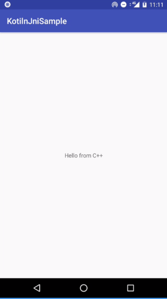Understanding Android NDK with Kotlin: Episode 2 — Callbacks(kotlin to cpp)
Previous article was mostly about the theoretical concepts that comes handy when working with the Android NDK.

I created a KotlinJniSample Application that has a simple HelloWorld example to showcase how native code is called from kotlin.

I created a class NativeStore to encapsulate the native methods.
The definition of the native function stringFromJNI()is available innative-lib.cpp file
and the MainActivity Class where we show TextView with text from the native code(A little DI magic can also be added to extract the initialization).
Now that we have everything ready its time to take a look at our CMakeLists.txt and gradle file.
CMake Configuration
Although Android creates the CMake file for us with all the relevant functions, a little information comes in handy if we change the library name or so.
In the CMakeLists.txt file: add_library function is used to add the path to the source code(in our case native-lib.cpp ).
There are a lot of CMake functions at our disposal.Let’s look at some of the core functions from the configuration:
- add_library: creates and names a library, sets it to either
STATICorSHARED, and provides the relative paths to its source code.
- find_library:searches for a specified pre-built library and stores the path as a variable.
- target_link_libraries:is used to specify libraries CMake should link to your target libraries that were created by
add_library.
Gradle Configuration
This part is handled in Android by default. We see a path to the CMakeLists.txt and cpp flags added to the gradle file.
Now that we have everything ready, we are good to run the app using NDK 🙌😎
Conclusion
In this article we saw how to create a simple APP using kotlin and NDK. If you liked this post, hit 👏 . Do hop in for the Episode-3 where we will see how to use callbacks from c++ to Kotlin.
TL;DR
- we use
init block of companion objectinstead ofstatic block - We use
externalkeyword instead ofnative. - Link to the source code.
originally posted in Medium
